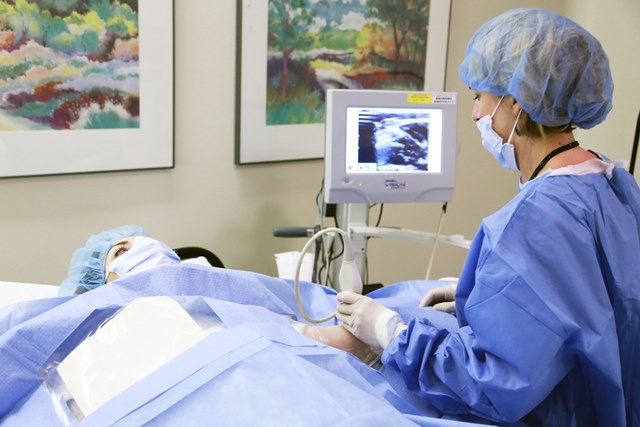The Intensive Care Unit (ICU) at St. Joseph’s Health Centre is a safe haven for quality care. Machines beep faintly as clinicians closely monitor the conditions of patients who are coping with serious illnesses or injuries. Those patients are being cared for around-the-clock by a dedicated team striving to improve their condition and, eventually, get them well enough to go back home.
The last thing you want to do with a fragile patient is take them out of that acute care setting.
With this in mind, St. Joseph’s Health Centre has launched a bedside program in our ICU for the insertion of a special type of intravenous access.
“We have had the support of the hospital to implement a new bedside peripherally inserted central catheter (PICC) program, where instead of having sick patients that are in the hospital come to (Diagnostic Imaging) to have this special intravenous inserted, we actually take our equipment to the patient,” explains Dr. Wendy Thurston, Chief of Diagnostic Imaging at St. Joe’s.
PICC lines are a type of intravenous access meant for long-term use. Each PICC line is a long, thin tube that is inserted by interventional radiology specialists through a vein in the upper arm. The tip of the tube is advanced through the vein until it ends in a large blood vessel near the heart. The lines are typically inserted using ultrasound and fluoroscopy. Fluoroscopy is an imaging technique that uses x-rays to obtain real-time moving images of the patient’s internal body.
Patients in areas such as the ICU have PICC lines inserted for various reasons, such as long-term intravenous access, nutrition, antibiotic usage or chemotherapy.
“If you’re going for chemotherapy with a regular intravenous, the chemotherapy burns your veins,” explains Lori Debono, a Registered Nurse at St. Joe’s who spearheaded our bedside PICC program alongside Dr. Thurston. “The PICC lines protect your veins.”
The PICC lines can also provide nutrients when people have surgery and can’t eat, she adds. “It acts as a substitute.”
MORE: THE DAY THE EMERGENCY WARD CALLED 911
When it comes to patient safety, those are some obvious benefits to using PICC lines – and our new beside program takes that safety focus one step further.
Debono has been the first staff member inserting PICCs at the bedside – a process she says cuts down on delays in treatment and the waiting times that crop up when you’re bringing patients down to the interventional radiology room.
Having the entire procedure done in a patients’ room decreases their level of discomfort. And, with the bedside program, it’s just one nurse inserting the PICC – speeding things up for the patient and reducing the amount of staff and time previously required to bring an ICU patient down several floors to Diagnostic Imaging (DI). In other words, a win-win situation.
“Staff say loud and clear that (the new bedside program) is safer for patients and provides better patient care and lower wait times,” says Julie Ann Ninnis, Patient Care Manager for the ICU.
MORE: NEW TREATMENT FOR PARKINSON’S DISEASE
Previously, when ICU patients would be shuttled down to DI, they’d often need a respiratory therapist on hand for the short trip to keep them breathing properly – since they wouldn’t be hooked up to an ICU ventilator. Staff would also be lugging the patient’s intravenous pole and other necessary equipment into an elevator. Overall, the medically necessary trip for a PICC line insertion was disruptive for the patient.
“When patients are sick and they have to be moved within the hospital, there’s an increase in adverse events that happen,” says Dr. Thurston. “And now the PICC lines are being done at the bedside, so it’s just been a positive thing for everybody – the patients, the interventional suite, and our hospital.”
Eventually, Dr. Thurston and Debono would love to see the bedside program spread to other units in the health centre. But in the meantime, for some of our sickest patients in the ICU, it’s already making a difference.
“I just can’t explain how great it is that we no longer have to move patients out of (the ICU), an area with all the necessary services and safety nets,” says Ninnis. “It’s much better to have the (PICC line) service come to the patient.”




